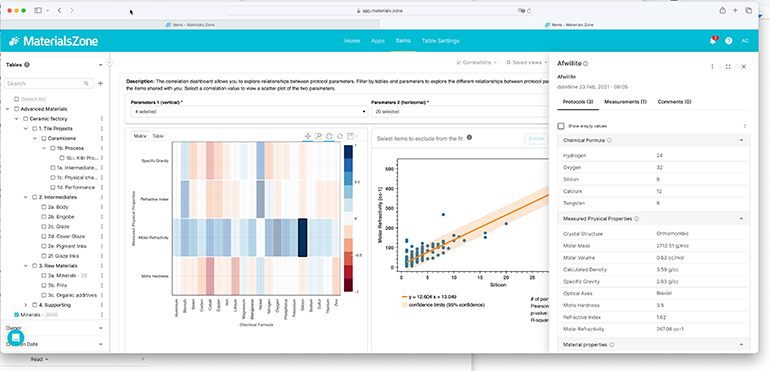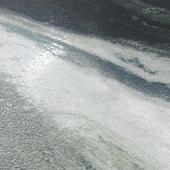Lean R&D. Analytic AI accelerates ceramic processes and materials development
“How does AI work for ceramics processes, and how does it apply for ceramic glaze or ceramic tile manufacturers today?”. Find out MaterialsZone’s solution.
By Warren Green, Alessandro Gozzi, Dr. Assaf Anderson - MaterialsZone (Israel)

MaterialsZone is a Materials Informatics solution combining a software platform and a service. It helps researchers and data scientists in industry accelerate new materials development by consolidating data and applying analytic and statistical techniques (AI/ML), providing insight and predictions for development teams.
The platform and the AI algorithms apply to most industries, the difference being the nature of the input data.
In this article we want to address a question we are frequently asked: “How does AI work for ceramics processes, and how does it apply for ceramic glaze or ceramic tile manufacturers today?”
What is AI?
Artificial Intelligence (AI) is a topic driving innovation and excitement across all industries. Is it really a mystery or just another way to use powerful computers and data to aid and improve the productivity of factories and development laboratories? By using a similitude, we can compare it to the GPS Navigator in our cars, it provides educated suggestions, but we make the decisions.
Also called Informatics, this field of science is concerned with aggregating and processing existing data ready to apply Analytic AI to accelerate development of new materials or re-formulating existing materials for revised attributes. It shortens the R&D process, speeds development, and improves real-time collaboration between global enterprise teams spread in different locations. At MaterialsZone we call it Lean R&D, which is materials development based on analytic AI and machine learning (ML).

Ceramic product innovation
Materials Informatics is a new and fast-growing market. No domain is better suited to benefit from this technology than ceramic tile manufacturers and related industries, such as ink, pigment, glaze, engobe or additive formulation, frit smelting, and body compositions. Similarly, suppliers of process equipment can model actual firing conditions. Ceramics is unique in its manufacturing complexity. Tile manufacturing occurs worldwide, and no two factories, or even glazing lines, have identical raw materials or process conditions. New tile collections require multiple formulation changes throughout development and many testing iterations to achieve the desired result. This back-and-forth, trial-and-error, through industrial kilns and glazing lines, consumes incredible amounts of time, energy, and resources. Moreover, the rapid shift to slab production has further increased the need for systems to control and predict the behavior of the decorated materials (therefore the whole decoration process) during the firing phase in the kiln. Much of this load falls on the glaze and machinery suppliers who must support an extensive catalogue of firing conditions, frits and glazes for each customer, a huge job considering that there are thousands of tile manufacturers worldwide.
Getting Started
What are the first steps with AI in the ceramics industry? The approach of MaterialsZone does not require additional specialists or data scientists and works within the framework of the customer’s established team. Upon joining the platform, MaterialsZone appoints a project manager and solutions engineer, a dedicated team that will work with the company through an active learning process to help identify and define the use cases and focus and the acceleration process to achieve the expected goals. Once understood, we can build a framework from existing data (or no data at all), to better implement the data strategy needed to achieve the targets. For companies that store their data and their knowledge in manual notebooks or excel worksheets, this will be the start of what is called the “digital journey”. Those companies who may have already implemented ELN (electronic laboratory notebooks) and/or LIMS (Laboratory Information Management Systems) can plug into the MaterialsZone platform at any level.
Identify the problem
Some challenges confronting the tile industry today are:
- Compliance with Sustainability and Regulation (reducing carbon footprint, toxic and polluting materials and processes).
- Variations in raw materials and processes.
- Rapid development of new bodies, glazes and surfaces.
- Cost reduction, waste reduction, and yield improvement.
Referring to sustainability, green hydrogen is a significant topic as far as ceramic R&D is concerned and requires management of the combustion trials and centralization of information, which can be supported by the MaterialsZone platform. Similarly, it can also help optimize glaze and body formulations and overcome local variations by selecting the best raw materials and predicting optimal conditions for the firing and smelting kilns. Overall cost reduction is also achieved with the digitalization of the entire R&D process achievable by the four pillars of the Lean R&D solution: Data aggregation, Collaboration hub, Visual Analyzer, Predictive co-pilot.
MaterialsZone solution
MaterialsZone follows a four-step approach.
Step 1. The company selects a use case, a particular issue, problem, or project it chooses to facilitate. It could be conversion to green hydrogen mixtures to fire the kiln, optimizing body formulations or engobes, managing frit smelting, or anything that requires iterative development. MaterialsZone has ready use cases for calculating glaze, body or frit compositions; it can also demonstrate sustainability calculations and how it deals with security issues, inside and outside the organization.
Step 2. The second step consists of identifying the relevant data to that use case or project. This data will generate insights and be accumulated securely in the Materials Knowledge Center. Over time, as the company moves from project to project, its knowledge base will expand and be available to all the organization and not be held under the control of individuals. This then transforms the whole R&D effort into a Collaborative Framework.
Step 3. At this stage, the company gains insight and detects patterns in its data, sometimes unexpectedly. Across the organization, the platform's Visual Analyzer is used to accelerate development.
Step 4. After assembling data and conducting trials, AI modeling of the process can occur. The predictive co-pilot offers experimental suggestions and predicts outcomes. This step can take place at any stage of the process.
Summary
Introducing AI in the ceramic industry to support innovation is a first important step and can start small. Tools can now enable to streamline R&D and preserve the corporate knowledge base. For years, the industry has kept financial accounts and money under tight control, and recently, CRM has also tightly organized the whole sales process, while the R&D process remained opaque. MaterialsZone can help management regain control of this strategic phase and allow product development teams and data scientists to increase their productivity and creativity.
MaterialsZone was recently featured in Gartner’s 2024 Market Guide for Materials Informatics Solutions as a leader in the Materials Informatics domain.
→ Follow MaterialsZone also on Linkedin
Did you find this article useful?
Join the CWW community to receive the most important news from the global ceramic industry every two weeks





















